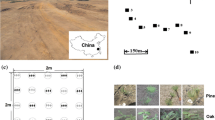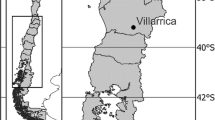Abstract
A field experiment was carried out to evaluate the growth response of Pinus halepensis seedlings inoculated with Pisolithus arhizus and planted in a terraced rangeland amended with urban solid refuse. The application of the organic amendment mediated a significant increase in soil fertility and soil water content. Twenty seven months after planting seedling survival rates did not differ significantly among treatments and were above 95% in all cases. Growth of P. halepensis was significantly (p<0.01) enhanced by the refuse application independently of their mycorrhizal status at the beginning of the experiment. A multiple regression analysis including available soil P concentration and sorptivity as independent variables explained up to 60% of the variance in pine growth observed across treatments. Inoculation with P. arhizus also significantly (p<0.01) enhanced pine growth with repect to the controls grown in both amended and nonamended plots. It was conduded that the combination of soil terracing, refuse amendment and P. arhizus inoculation significantly improved the performance of Pinus halepensis, and this methodology could be successfully applied in afforestation programmes in semiarid and degraded sites.
Similar content being viewed by others
References
Albaladejo J and Diaz E 1990 Degradación y regeneración del suelo en el litoral mediterráneo español: Experiencias en el Proyecto LUCDEME. In Degradación y Regeneración del Suelo en Condiciones Ambientales Méditerráneas. Eds. JAlbaladejo, M AStocking and EDiaz. pp 191–212. Consejo Superior de Investigaciones Cientificas, Murcia, Spain.
Albaladejo J, Stocking M, Diaz E and Castillo V 1994 Land rehabilitation by urban refuse amendments in a semiarid environment: effect on soil chemical properties. Soil Technol. 7, 249–260.
Alvarez I 1991 Ecología, fisiología e implicaciones prácticas de las microrrizas. In Fijación y Movilización Biológica de Nutrientes, Vol II, Fijación de N y Micorrizas. Eds. JOlivares and J MBarea. pp 247–259. Consejo Superior de Investigaciones Científicas, Madrid, Spain.
Allen M F 1989 Mycorrhizae and rehabilitation of disturbed arid soils: processes and practices. Arid Soil Res. Rehab. 3, 229–241.
Allen M F 1991 The Ecology of Mycorrhizae. Cambridge University Press, Cambridge, UK. 184p.
Amaranthus M P and Perry D 1989 Rapid root tip and mycorrhiza formation and increased survival of Douglas-fir seedlings after soil transfer. New For. 3, 77–82.
Amaranthus M P and Trappe J M 1993 Effect of erosion on ecto- and VA-mycorrhizal inoculum potential of soil following forest fire in southwest Oregon. Plant and Soil 150, 41–49.
Aniwat C and Somboon B 1990 Growth and nutrient uptake of Eucalyptus camaldulensis and Pinus caribaea var. hondurensis seedlings grown on old tin-mined soils after Pisolithus tinctorius ectomycorrhizal inoculation and manure fertilization. In Current Trends in Mycorrhizal Research. Eds. L Jalali and H Chand. pp 49–50. Proceedings of the National Conference on Mycorrhiza, Haryana Agricultural University, Hisar, India.
Aziz T and Habte M 1989 Enhancement of endomycorrhizal activities through nitrogen fertilization in cowpea grown in an Oxisol subjected to simulated erosion. Arid Soil Res. Rehab. 4, 131–139.
Boyle C D and Hellenbrand K E 1991 Assessment of the effect of mycorrhizal fungi on drought tolerance of conifer seedlings. Can. J. Bot. 69, 1764–1771.
Brink R H, Dubach P and Lynch D L 1960 Measurements of carbohydrates in soil hydrolizates with anthrone. Soil Sci. 89, 157–166.
Chevalier G and Detolle M 1984 Obtention de bolets de pin Suillus collinitus (Fr.) O Kuntze, en pot, sur plantules de pin d'Alep mycorrhizées artificiellement en conditions controlées. Agronomie 4, 211.
Colombo B and Baccanti M 1989 A new method for the authomatic and selective determination of total organic carbon in sediments, soils, compost, etc. XI International Symposium on Microchemical Techniques, Wiesbaden, Germany.
Cumming J R 1993 Growth and nutrition of nonmycorrhizal and mycorrhizal pitch pine (Pinus rigida) seedlings under phosphorus limitation. Tree Physiol. 13, 173–187.
Danielson R M 1991 Temporal changes and effects of amendments on the occurrence of sheating (ecto-) mycorrhizas of conifers growing in oil sand tailings and coal spoil. Agric. Ecosyst. Environ. 35, 261–281.
Danielson R M, Griffiths C L and Parkinson D 1990 Effects of fertilization on the growth and mycorrhizal development of container-grown jack pine (Pinus banksiana) seedlings. For. Sci. 30, 828–835.
David A, Faye M and Rancillac M 1983 Influence of auxin and mycorrhizal fungi on the in vitro formation and growth of Pinus pinaster roots. Plant and Soil 71, 501–505.
Diaz E, Roldán A, Lax A and Albaladejo J 1994 Formation of stable aggregates in a degraded soil by amendment with urban refuse and peat. Geoderma 63, 277–288.
Ek M, Ljungquist P D and Stenstrom E 1983 Indole-3-acetic acid production by mycorrhizal fungi on the in vitro formation and growth of Pinus pinaster roots. Plant and Soil 71, 501–505.
Elena-Roselló R, Sánchez-Palomares O, Carretero P and Ruiz del Castillo J 1990 Integración ecológica de las repoblaciones de Pinus nigra spp. nigra de Navarra. Ecología 1, 541–560.
Finkel H J 1986 Engineering measures for soil and water conservation: terracing and benching. In Semiarid Soil and Water Conservation. Ed. H JFinkel. pp 85–91. CRC Press, Florida, USA.
García C, Hernández T and Costa F 1992 Variations in some chemical parameters and organic matter in soils regenerated by the addition of municipal solid waste. Environ. Manage. 16, 763–768.
Grand L F and Harvey A E 1982 Quantitative measurements of ectomycorrhizae on plant roots. In Methods and Principles of Mycorrhizal Research. Ed. N CSchenck. pp 157–164. Am. Phytopathol. Soc., Saint Paul, USA.
Guehl J M, Mousain D, Falconnet G and Gruez J 1990 Growth, carbon dioxide assimilation capacity and water use efficiency of Pinus pinea L seedlings inoculated with different ectomycorrhizal fungi. Ann. Sci. For. 47, 91–100.
Guidi G, Pagliai M and Giachetti M 1983 Modifications of some physical and chemical soil properties following sludge and compost applications. In The Influence of Sewage Sludge Application on Physical and Biological Properties of Soils. Eds. CCatraux, PL'Hermite and ESuess. pp 122–133. D Reidel, Dordrecht, The Netherlands.
Habte M 1989 Impact of simulated erosion on the abundance and activity of indigenous vesicular arbuscular mycorrhizal endophytes in an Oxisol. Biol. Fertil. Soils 7, 164–167.
Harley J L and Smith S E 1983 Mycorrhizal Symbiosis. Academic Press, London, UK. 483p.
Kushner D J 1980 Extreme environments. In Contemporary Microbial Ecology. Eds. D CEllwood, J NHedger, M JLatham, J MLynch and J HSlater. pp 29–54. Academic Press, London, UK.
Lapeyrie F 1990 The role of ectomycorrhizal fungi in calcareous soil tolerance by “symbiocalcicole” woody plants. Ann. Sci. For. 47, 579–589.
Lax A, Díaz E, Castillo V and Albaladejo J 1994 Reclamation of physical and chemical properties of a salinized soil by organic amendment. Arid Soil Res. Rehab. 8, 9–17
Linderman R G 1989 Organic amendments and soil borne diseases. Can. J. Plant Pathol. 16, 763–768.
Marschner H 1986 Mineral Nutrition of Higher Plants. Academic Press, New York, USA. 674p.
Marx D H, Hatch A B and Medicino J F 1977 High soil fertility decreases sucrose content and susceptibility of lobolly pine roots to ectomycorrhizal infection by Pisolithus tinctorius. Can. J. Bot. 55, 1569–1574.
Murphy J and Riley J P 1962 A modified single solution method for the determination of phosphate in natural waters. Anal. Chim. Acta 27, 31–36.
Olsen S R, Cole C V, Watanabe F S and Dean L A 1954 Estimation of available phosphorous in soils by extraction with sodium bicarbonate. US Dep. Agric. Circ. 939, Washington, USA.
Page A L, Miller R H and Keeny O R 1982 Methods of Soil Analysis, Part 2. American Society of Agronomy, Madison, USA. 1159 p.
Pera A, Giovannetti M, Vallini G and DeBertoldi M 1983 Land application of sludge: effects on soil microflora. In The Influence of Sewage Sludge Application on Physical and Biological Properties of Soils. Eds. GCatroux, PL'Hermite and ESuess. pp 208–228. D Reidel, Dordrecht, The Netherlands.
Perry D A, Molina R and Amaranthus M P 1987 Mycorrhizae, mycorrhizospheres, and reforestation: current knowledge and research needs. Can. J. For. Res. 17, 929–940.
Philip J R 1957 The theory of infiltration 4: sorptivity and algebraic infiltration equation. Soil Sci. 84, 257–264.
Reinersten S A, Elliot L F, Cochran V L and Campbell G S 1984 Role of available carbon and nitrogen in determining the rate of wheat straw decomposition. Soil Biol. Biochem. 16, 459–464.
Roldán A and Albaladejo J 1993 Vesicular-Arbuscular Mycorrhiza (VAM) fungal populations in a xeric Torriorthent receiving urban refuse. Soil Biol. Biochem. 25, 451–456.
Roldán A and Albaladejo J 1994 Effect of mycorrhizal inoculation and soil restoration on the growth of Pinus halepensis seedlings in a semiarid soil. Biol. Fertil. Soils 18, 143–149.
Roldán A, García-Orenes F and Lax A 1994 An incubation experiment to determine factors involving aggregation changes in an arid soil receiving urban refuse. Soil Biol. Biochem. 26, 1699–1707.
Rousseau J V D and Reid C P P 1991 Effects of phosphorus fertilization and mycorrhizal development on phosphorus nutrition and carbon balance of lobolly pine. New Phytol. 117, 319–326.
Ruehle J L, Marx D H and Auborough M 1981 Development of Pisolithus tinctorius and Telephora terrestris ectomycorrhizae on seedlings of coniferous trees important to Morocco. Ann. Rech. For. Maroc. 1, 283–296.
Schollemberger C F and Simon R H 1954 Determination of exchange capacity and exchangeable bases in soils. Soil Sci. 59, 13–24.
Serrada R 1990 Consideraciones sobre el impacto de la repoblacion forestal en el suelo. Ecología 1, 453–462.
Soil Survey Staff 1975 Soil taxonomy: a Basic System of Soil Classification for Making and Interpreting Soil Surveys. USDA Handbook 436. US Government Printing Office, Washington, USA.
Sutikto T and Chikamori K 1993 Evaluation of Philip's infiltration equation for cultivated upland terraces in Indonesia. J. Hydrol. 143, 279–295.
Tisdall J M and Oades J M 1982 Organic matter and water stable aggregates in soils. Soil Sci. 33, 141–163.
Torres P and Honrubia M 1993 Ectomycorrhizal associations proven for Pinus halepensis. Isr. J. Plant Sci. 42, 51–58.
Torres P and Honrubia M 1994 Inoculation of containerized Pinus halepensis (Miller) seedlings with basidiospores of Pisolithus arhizus (Pers.) Rauschert, Rhizopogon roseolus (Corda) Th M Fr and Suillus collinitus (Fr.) O Kuntze. Ann. Sci. For. 51, 521–528.
Trappe J M 1981 Mycorrhizae and productivity of arid and semiarid rangelands. In Advances in Food Producing Systems for Arid and Semiarid Lands. Eds. J TManassah and E JBriskey. pp 581–599. Academic Press, New York, USA.
Tyminska A, LeTacon F and Chadoeuf J 1986 Effect of three ectomycorrhizal fungi on growth and phosphorus uptake of Pinus sylvestris seedlings at increasing phosphorus levels. Can. J. Bot. 64, 2753–2757.
Author information
Authors and Affiliations
Rights and permissions
About this article
Cite this article
Roldan, A., Querejeta, I., Albaladejo, J. et al. Growth response of Pinus halepensis to inoculation with Pisolithus arhizus in a terraced rangeland amended with urban refuse. Plant Soil 179, 35–43 (1996). https://doi.org/10.1007/BF00011640
Received:
Accepted:
Issue Date:
DOI: https://doi.org/10.1007/BF00011640




